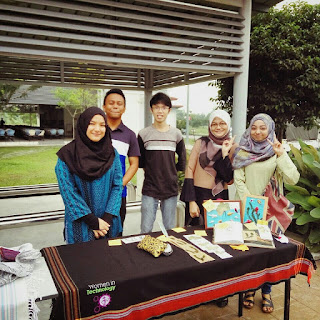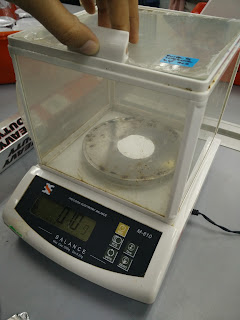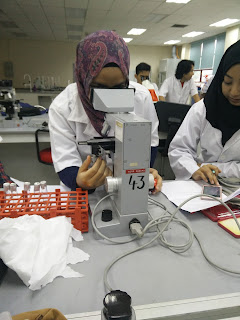Halodule pinifolia is a needle-like sea grass often seen in large shore where it is commonly found on the seaward side of sand bars. The sea grass is really hardy plant where it can tolerate high disturbance in the natural. In this practical report, we would like to test and observe the condition of H.pinifolia if the sea grass is cultured indoor. The sea grass, seawater sample and the substrate was collected at Teluk Kemang, Port Dickson and was brought back to UPM, Serdang. In order to culture it in the lab, similar condition and water parameter as in the natural ecosystem was provided. Thus, the sea grass was monitored gradually for its growth and performance.
Objective
To observe the characteristics and morphology of the selected sea grass.
To be able to successfully culture sea grass in an indoor aquarium.
To observe the life cycle of sea grass.
Materials and Methods
1. Seagrass sampling
The selected sea grass was Halodule pinifolia, which was found in abundance at Teluk Kemang, Port Dickson. The area in which the specimen was taken was a sandy substrate. H. pinifolia was easily identified by its hair like leaf that can be seen on the surface of the sand in low tide. A few samples was carefully taken by scooping the sand along with the sea grass to avoid damaging its submerged rhizome. Samples was placed in a plastic bag and brought back to the lab.
 |
| Image 1: Collection of sea grass sample at Teluk Kemang. |
 |
| Image 2: Hair-like leaf of Halodule pinifolia. |
 |
| Image 3: Scooping the sample along with its substrate to avoid damaging the rhizome. |
2. Preparing Culture Equipment
Equipments used was two sieved basket(Small), a fine mesh placed on the basked, A plastic aquarium and aeration. A single sample was placed in a prepared basket along with its soil and toothpicks was placed on each end of the rhizome to record growth. Once prepared, each basked is placed into an aquarium filled with seawater and provided enough aeration and sunlight.
 |
| Image 4: Preparing basket with fine mesh sieve to hold substrate. |
 |
| Image 5: Placing collected substrate onto each basket. |
 |
| Image 6: Cleaning sea grass sample from stones and debris. |
 |
| Image 7: Measuring selected sea grass sample before planting onto prepared substrate. |
 |
| Image 8: Completed culture tank for sea grass. |
Starting from day one, the growth of rhizome is measured and recorded weekly. Additional experiment was done by removing all the leaves of a sea grass sample to observe the growth of new leaves. The results was recorded and shown in the results section.
 |
| Image 9: Measuring the growth of new leaves. |
 |
| Image 10: Measuring the growth of new leaves in each sample. |
 |
| Image 11: Extra sample of sea grass placed without substrate shows this species is able to grow easily with suitable water parameters. |
4. Water Parameters
Water parameters was taken to observe the water quality in which the sea grass has been growing on for a few weeks. The DO, pH, Ammonia and Salinity was taken and recorded.
 |
| Image 12: Taking DO reading using a DO meter which was 8 mg/l, |
 |
| Image 13: Checking salinity with a refractometer. |
 |
| Image 14: Checking ammonia using an ammonia test kit. |
 |
| Image 15: Ammonia reading for the sea grass culture was close to 0. |
Results
|
Basket
|
Seagrass (row)
|
Before (cm)
(29/9/15)
|
After (cm)
(1/10/15)
|
|
A
|
I
|
5.0
|
5.1
|
|
II*
|
6.5
|
6.7
|
|
|
B
|
I
|
5.3
|
5.5
|
|
II
|
5.5
|
5.6
|
|
|
III
|
9.0
|
9.3
|
*the leaves are picked to observe a growth of new shoots
Discussion
Halodule pinifolia are widely known as a very tough plant able to withstand a very adverse condition. Therefore the plant can easily grow anywhere including in our tank. The plant shows continuous growth even after the experiment period where they get rid of old leaves and grow the new one. One of the basket is removed after a while to observe to have the plant in its optimum condition. The water level in the tank is also kept in check where it is refilled when it is evaporated, There is one way to keep the plant grow at its best which is to place the basket at the depth same as the water tide timetable at its origin.
Conclusion
Halodule pinifolia was successfully cultured in an indoor room (in the lab). The length of the leaf seems to be increasing. There was no sign of yellowish or dead parts from the seagrass even with no sunlight expose to it. Perhaps the lighting in the lab is enough for it to survive. Moreover, new shoots starts to emerge and we also tested the seagrass without any substrate to it. Surprisingly, it does live, provided the water parameter is suitable for it to grow which is somewhat similar as in the natural environment.
References
- http://www.wildsingapore.com/wildfacts/plants/seagrass/halodule.htm




















































